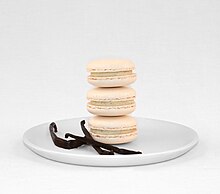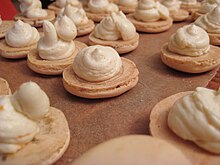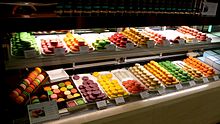Macaron
 Parisian-style macarons (vanilla flavour) | |
| Alternative names | French macaroon |
|---|---|
| Type | Confectionery |
| Place of origin | France |
| Created by | Pierre DesfontainesorClaude Gerbet |
| Main ingredients | Cookie:egg white,icing sugar,granulated sugar,almond powder,food colouring Filling:buttercreamorclotted cream,ganache,orjam |

Amacaron(/ˌmækəˈrɒn/MAK-ə-RON,[1][2]French:[makaʁɔ̃]) orFrench macaroon(/ˌmækəˈruːn/MAK-ə-ROON) is a sweetmeringue-basedconfectionmade withegg white,icing sugar,granulated sugar,almond meal,and oftenfood colouring.[3]
Since the 19th century, a typical Parisian-style macaron has been asandwich cookiefilled with aganache,buttercreamorjam.As baked, the circular macaron displays a smooth, square-edged top, a ruffled circumference—referred to as the "crown" or "foot" (or "pied" )—and a flat base. It is mildly moist and easily melts in the mouth. Macarons can be found in a wide variety of flavours that range from traditional sweet such asraspberryorchocolateto savoury (as afoie gras).[4]
Name
There is some variation in whether the termmacaronormacaroonis used, and the relatedmacaroonis often confused with the macaron. In North America, most bakers have adopted the French spelling ofmacaronfor the meringue-based treat to distinguish the two. The two confections have a shared history withmacaroni(Italian:maccheroni,from Greek μακαρία). French words ending with "-on" that were borrowed into English in the 16th and 17th centuries are usually spelled with "-oon" (for example:balloon,cartoon,platoon).[5]In the UK, many bakeries continue to use the termmacaroon.[6][7]
History
Although the sandwich-style macaron that we know today was created inParisbyClaude Gerbet,we can trace the story of the macaron to other almond-based cakes that appeared earlier.[8]
Arab troops fromIfrīqiya(nowTunisia)occupied Sicilyin 827. They brought with them nut-based sweets such asfālūdhajandlausinaj—baked goods with sweet almond cream inside. These pastries had been handed down by theSassanidshahsinPersia,where the almond cake was made to celebrate theZoroastrianNew Year (Nowruz). In Sicily and inToledo, Spain,another contact point between Muslim and Christian culture, fālūdhaj and lausinaj developed into various desserts, such as the almond-paste tarts calledmarzapaneandcaliscioni.[9]
Some food historians[10]trace the origin of macarons to aFrenchmonastery in Cormeryin the 8th century (791),[11][12]in theLoire Valley.This particular macaron is made with egg whites, sugar and almonds.[13]
A Swiss online encyclopedia on the history of baking says that they were brought fromal-Andalus(present-daySpain) toMarrakesh(present-dayMorocco) in the early 11th century by the sultan and first king of the Almoravid dynasty Yusuf ibn Tashfin, and that they were served mainly during Ramadan.[14]
A popular legend tells that the macaron was introduced inFranceby a chef ofCatherine de Medici,however, a thorough investigation of records listing service personnel who worked with Catherine since her arrival inFranceuntil her death revealed the absence of anyItalianchefs.[15][16]

In the 1790s, macarons began to gain fame when two Carmelite nuns, seeking asylum inNancyduring theFrench Revolution,baked and sold the macaron cookies in order to pay for their housing. These nuns became known as the "Macaron Sisters". In these early stages, macarons were served without special flavours or fillings.[17][18]
It was not until the 1930s that macarons began to be served as sandwich cookies with the addition of jams, liqueurs, and spices. The macaron as it is known today, composed of two almond meringue discs filled with a layer of buttercream, jam, organache,was originally called the "Gerbet" or the "Paris macaron".Pierre Desfontaines,of the French pâtisserieLadurée,has sometimes been credited with its creation in the early part of the 20th century, but another baker, Claude Gerbet, also claims to have invented it.[5][19]French macaron bakeries became trendy in North America in the 2010s.[20]
Earliest recipe
The earliest known recipe dates back to the early 17th century and appears to be inspired by a French version of the recipe.
To make French Macaroones
Wash a pound of the newest and the best Jordane Almonds in three or foure waters, to take away the rednesse from their out-side, lay them in a Bason of warme water all night, the next day blanch them, and dry them with a faire cloath, beat them in a stone morter, until they be reasonably fine, put to them halfe a pound of fine beaten Sugar, and so beat it to a perfect Paste, then put in halfe a dozen spoonefuls of goodDamaskeRose-water,three graines ofAmbergreece,when you have beaten all this together, dry it on achafingdishof coales until it grow white and stiffe, then take it off the fire, and put the whites of two new laid Egs first beaten into froath, and so stirre it well together, then lay them on wafers in fashion of little long rowles, and so bake them in an Oven as hot as forManchet,but you must first let the heat of the Oven passe over before you put them in, when they rise white and light, take them out of the Oven, and put them in a warm platter, and set them againe into the warme Oven & so let them remain foure or five houres, and then they wil be thoroughly dry, but if you like them better being moist, then dry them not after the first baking.— John Murrell,A Daily Exercise for Ladies and Gentlewomen(1617)[21]
Method

There are two main methods for making a macaron – using either French or Italianmeringue(which also originated inFrancedespite its name[22]).
In the French method, egg whites are whisked until stiff-peaked meringue forms. From there, sifted, ground almonds and powdered sugar are folded in slowly until the desired consistency is reached. This process of knocking out air and folding is called macaronage.[23]
In the Italian, egg whites are whisked with hot sugar syrup to form a meringue. Sifted almonds and icing sugar are separately mixed with raw egg whites to form a paste. The meringue and almond paste are mixed together to form the macaron mixture. This method is often deemed more structurally sound yet also sweeter and also requires a candy thermometer for the sugar syrup.
A vegan variation involves the use of aquafaba in place of egg white. All other ingredients are essentially the same.
Either Italian or French meringue can be combined with ground almonds.[24]The two elements are then folded together until they are the consistency of "shaving foam", and then are piped, left to form a skin, and baked.[25]Sometimes, a filling is added.
Variations



France
Several French cities and regions claim long histories and variations, notablyLorraine(NancyandBoulay),Basque Country(Saint-Jean-de-Luz),Saint-Émilion,Amiens,Montmorillon,Le Dorat,Sault,Chartres,Cormery,Joyeuseand Sainte-Croix in Burgundy.
Macarons d'Amiens, made inAmiens,are small, round-shaped biscuit-type macarons made fromalmond paste,fruit and honey, which were first recorded in 1855.[26]
The city ofMontmorillonis well known for its macarons and has a museum dedicated to them. The Maison Rannou-Métivier is the oldest macaron bakery in Montmorillon, dating back to 1920. The traditional recipe for Montmorillon macarons has remained unchanged for over 150 years.[27]
The town ofNancyin theLorraineregion has a storied history with the macaron. It is said that the abbess ofRemiremontfounded an order of nuns called the "Dames du Saint-Sacrement" with strict dietary rules prohibiting the consumption of meat. Two nuns, Sisters Marguerite, and Marie-Elisabeth are credited with creating the Nancy macaron to fit their dietary requirements. They became known as the 'Macaron Sisters' (Les Soeurs Macarons). In 1952, the city of Nancy honoured them by giving their name to the Rue de la Hache, where the macaron was invented.[28][18]
India
ThoothukudiinTamil Naduhasits own varietyof macaroon made with cashews instead of almonds, adapted from macarons introduced in colonial times.[29]
Japan
Macarons inJapanare a popular confection known as マカロン (makaron).[30]There is also another widely available version ofmakaronwhich substitutespeanutflour for almond and awagashi-style flavouring. Themakaronis featured in Japanese fashion through cell phone accessories, stickers, and cosmetics aimed towards women.[31]
Switzerland
InSwitzerland,Luxemburgerli(also Luxembourger) are a brand name of macaron[32][33]made byConfiserie SprüngliinZürich.ALuxemburgerlicomprises two disks of almond meringue[34]with a buttercream filling[35]in of many available flavors.[36]Luxemburgerli are smaller and lighter than macarons from many other vendors.
United States
Pastry chefs in the US have expanded the classic cookie to include such varied flavours as mint chocolate chip, peanut butter and jelly, Snickers, peach champagne, pistachio, strawberry cheesecake, candy corn, salted pretzel, chocolate peanut butter, oatmeal raisin, candy cane, cinnamon, maple bacon, pumpkin, and salted caramel popcorn.[37]
South Korea
In addition to macarons, fat-carons (뚱까롱, thick macarons), also called ttungcarons, were invented and became popular in South Korea. The bakers intentionally overfill the macaron filings and later decorate them as well. The appearance can resemble more to that of a small ice cream sandwich.[38]
Popularity
In Paris, theLaduréechain of pastry shops has been known for its macarons for about 150 years[update].[39][40]
In Portugal, Spain, Australia, France, Belgium, Switzerland, New ZealandMcDonald'ssells macarons in theirMcCafés(sometimes using advertising that likens the shape of a macaron to that of a hamburger).[39]McCafé macarons are produced by Château Blanc, which, like Ladurée, is a subsidiary ofGroupe Holder,though they do not use the same macaron recipe.[39]
Outside of Europe, the French-style macaron can be found inCanada[41]and theUnited States.[42][43][44]
InAustralia,Adriano Zumboand his TV seriesMasterChefhave contributed to the macaron becoming a popular sweet treat, and it is now sold by McDonald's in its Australian McCafe outlets.[45]
See also
- Macaroon
- Sandwich cookie
- Alfajor– a similar Spanish confection
- Petit four
- Empire biscuit
- Fudge cookie
- Jammie Dodgers
- List of almond dishes
Notes
- ^"Definition of macaron in English".Oxford Dictionaries.Archived fromthe originalon 16 April 2018.Retrieved16 April2018.
- ^"Definition of macaron".Merriam-Webster.Retrieved16 April2018.
- ^Marsh, Janine (26 July 2021)."Cormery Macarons, Loire Valley speciality".The Good Life France.Retrieved20 March2023.
- ^"Macaron".Dessert Eater.Archived fromthe originalon 11 August 2013.
- ^abJurafsky (2011b).
- ^"Macaron vs Macaroon - What's in a name anyway?".Anges de Sucre.Retrieved18 March2020.
- ^"Macaroon or Macaron?".Miss Macaroon.Retrieved18 March2020.
- ^Jurafsky, Dan (15 September 2014).The Language of Food: A Linguist Reads the Menu.W. W. Norton & Company.ISBN978-0-393-24587-5.
- ^Dan Jurafsky (16 November 2011)."Macarons, Macaroons, Macaroni. The curious history".Slate.Retrieved4 June2021.
- ^Sheraton, Mimi (13 January 2015).1,000 Foods To Eat Before You Die: A Food Lover's Life List.Workman Publishing Company.ISBN978-0-7611-8306-8.
- ^Dena Kleiman (20 March 1991)."The 5th Question At the Seder: Have a Macaroon?".New York Times.Retrieved4 June2021.
- ^Prosper Montagné (1988).Larousse gastronomique.
- ^Duboquet, Constance (27 September 2023).Dis Mamou, on cuisine quoi aujourd'hui?(in French). Larousse.ISBN978-2-03-605434-9.
- ^"Pièces sèches: Macarons".Lexique de Boulangerie-Pâtisserie.ch. Archived fromthe originalon 17 September 2014.Retrieved4 June2021.
- ^Collectif (6 December 2022).La table de la Renaissance: Le mythe italien(in French). Presses universitaires François-Rabelais. p. 85.ISBN978-2-86906-842-1.
- ^"Consultation".archivesetmanuscrits.bnf.fr.Retrieved26 May2023.
- ^Robyn Lee."Introduction to French Macarons".Serious Eats.
- ^abTucker, Hugh (17 May 2022)."The true origin of French macarons".BBC Travel.Retrieved18 May2022.
- ^Elena Ferretti (30 November 2009)."Macarons, the Daddy Mac of Cookies".Fox News.
- ^Mary Chao (11 June 2014)."The French Macaron Trend".Democrat & Chronicle.
- ^John Murrell (1617).A Daily Exercise for Ladies and Gentlewomen(PDF).
- ^"Ouverture de cuisine | WorldCat.org".www.worldcat.org.Retrieved20 March2023.
- ^"French pâtisserie technique: Macaronage".Le Cordon Bleu.
- ^"How to cook perfect chocolate macarons".The Guardian.16 May 2012.
- ^"Macaron Myth Buster: French or Italian?".The World of Anges.22 February 2015.
- ^Nick Rider (1 May 2005).Short Breaks Northern France.New Holland Publishers. p. 135.ISBN9781860111839.[permanent dead link]
- ^Cécile Teurlay (July–August 2003)."Montmorillon — Le musée du Macaron et de l'Amande"[Montmorillon — The Macaron and Almond Museum].Musée de l'Amande et du Macaron(in French). Archived fromthe originalon 15 June 2006.Retrieved8 December2012.
- ^"Maison des Soeurs Macarons > Notre Histoire..."achatville.com(in French). Archived fromthe originalon 17 October 2020.Retrieved24 March2018.
- ^Olympia Shilpa Gerald (8 December 2012)."In search of Thoothukudi macaroon".The Hindu.Retrieved30 June2013.
- ^Jean-Philippe Darcy (9 July 2010)."Hạ の tân tác マカロン"[Summer New Macaroons] (in Japanese). Fukui News. Archived fromthe originalon 17 March 2012.Retrieved8 May2012.
- ^Anderson, Sarah (15 August 2015)."Destination JS: Macaron Edition".Japan Society.Retrieved30 September2015.
- ^Hubbeling, Christina (10 October 2009)."Wer macht die besten Macarons?"[Who makes the best macarons?].Neue Zürcher Zeitung(in German).Retrieved3 March2014.
- ^Böhler, Guido (20 March 2010)."Macarons: wer macht die besten und schönsten?"[Macarons: who makes the best and most attractive?].delikatessenschweiz.ch(in German).Retrieved3 March2014.
- ^Malgieri, Nick (21 July 1994)."Baking: How to Make a Macaroon".Los Angeles Times.Retrieved15 August2024.
- ^Kummer, Corby (30 March 2011)."Smackaroon! The Switzerland vs. France Cookie Smackdown".The Atlantic.The Atlantic Monthly Group.Retrieved3 March2014.
- ^"Luxemburgerli Flavours".www.spruengli.ch.
- ^Thomson, Julie R. (9 October 2012)."Americanized Macaron Recipes: French Cookies With American Flavors (PHOTOS)".HuffPost.Huffington Post.Retrieved30 September2015.
- ^"[맛있는 이야기] 마카롱 얼마나 아세요? 마카롱의 역사".문화뉴스(in Korean). 24 March 2021.Retrieved18 April2021.
- ^abcJargon, Julie (2 March 2010)."Mon Dieu! Will Newfound Popularity Spoil the Dainty Macaron?".The Wall Street Journal.Retrieved29 December2010.
- ^Reed, M. H. (29 January 2009)."Macaroon Delight".The New York Times.Retrieved29 December2010.
- ^Chesterman, Lesley (11 October 2008)."Macaron mania hits Montreal - finally!".The Gazette (Montreal). Archived fromthe originalon 9 November 2012.Retrieved29 December2010.
- ^Denn, Rebekah (25 October 2009)."French macarons are sweet, light and luscious".The Seattle Times.
- ^Greenspan, Dorie (1 April 2010)."Macarons: New to The Easter Parade This Year".Los Angeles Times.Retrieved15 August2024.
- ^Neda Ulaby (12 February 2010)."Move Over, Cupcake: Make Way For The Macaroon".NPR.Retrieved29 December2010.
- ^Chavassieu, Olivia (15 April 2008)."Heaven on Earth".Sydney Morning Herald.Retrieved7 March2012.
References
- Meyers, Cindy (Spring 2009). "The Macaron and Madame Blanchez".Gastronomica. The Journal of Food and Culture.9(2). University of California Press: 14–18.doi:10.1525/gfc.2009.9.2.14.JSTOR10.1525/gfc.2009.9.2.14.
- Jurafsky, Dan (16 November 2011b)."Macarons, Macaroons, Macaroni — The curious history".Slate.Archivedfrom the original on 13 October 2013.(About the history of the macaron.)
- Jurafsky, Dan (16 April 2011a)."Macaroons, Macarons, and Macaroni".The Language of Food.
Further reading
- B. Clermont (1776),"Des Macarons; commonly called Macaroni-drops",The professed cook, or, The modern art of cookery, pastry, and confectionary, made plain and easy,London: W. Davis,OCLC6194222,OL7237714M
- Louise-Béate-Augustine Friedel (1811),Le confiseur impérial, ou, L'art du confiseur dévoilé aux gourmands,A Paris: Chez Henri Tardieu,OCLC61172534,OL25072827M
- Frances Crawford (1853)."Macarons".French confectionary adapted for English families.London: Richard Bentley.
- Emile Herisse (1893),"Macaroons",The art of pastry making,London: Ward, Lock, Bowden,OL13878920M
